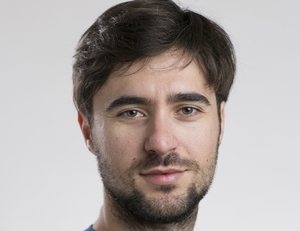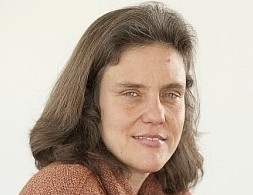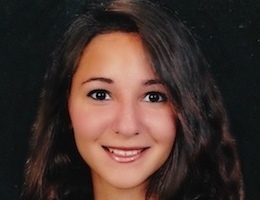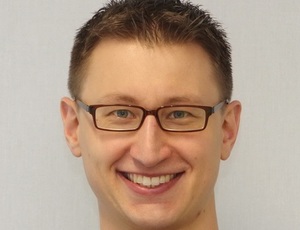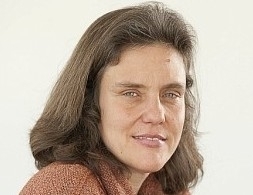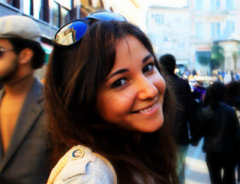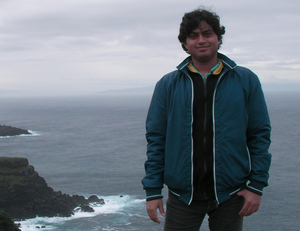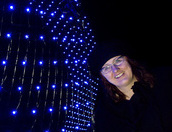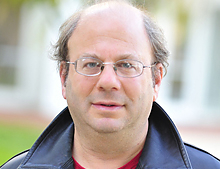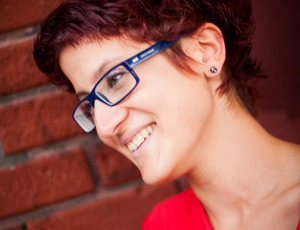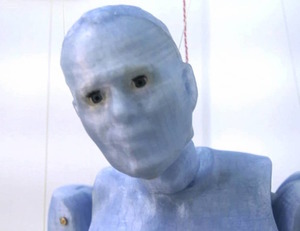Events & Talks
Perceiving Systems
Talk
Endri Dibra
30-05-2017
3D shape from monocular images with data-driven priors
Estimating 3D shape from monocular 2D images is a challenging and ill-posed problem. Some of these challenges can be alleviated if 3D shape priors are taken into account. In the field of human body shape estimation, research has shown that accurate 3D body estimations can be achieved through optimization, by minimizing error functions on image cues, such as e.g. the silhouette. These methods though, tend to be slow and typically require manual interactions (e.g. for pose estimation). In this talk, we present some recent works that try to overcome such limitations, achieving interactive rate...
Gerard Pons-Moll
Perceiving Systems
Talk
Sven Dickinson
29-05-2017
The Perceptual Advantage of Symmetry for Scene Perception
Human observers can classify photographs of real-world scenes after only a very brief exposure to the image (Potter & Levy, 1969; Thorpe, Fize, Marlot, et al., 1996; VanRullen & Thorpe, 2001). Line drawings of natural scenes have been shown to capture essential structural information required for successful scene categorization (Walther et al., 2011). Here, we investigate how the spatial relationships between lines and line segments in the line drawings affect scene classification. In one experiment, we tested the effect of removing either the junctions or the middle segments between juncti...
Ahmed Osman
Perceiving Systems
Talk
Yael Moses
24-05-2017
Dynamic Scene Analysis Using CrowdCam Data
Dynamic events such as family gatherings, concerts or sports events are often photographed by a group of people. The set of still images obtained this way is rich in dynamic content. We consider the question of whether such a set of still images, rather the traditional video sequences, can be used for analyzing the dynamic content of the scene. This talk will describe several instances of this problem, their solutions and directions for future studies.
In particular, we will present a method to extend epipolar geometry to predict location of a moving feature in CrowdCam images. The method ...
Jonas Wulff
Perceiving Systems
Talk
Cordelia Schmid
19-05-2017
Learning to segment moving objects
This talk addresses the task of segmenting moving objects in unconstrained videos. We introduce a novel two-stream neural network with an explicit memory module to achieve this. The two streams of the network encode spatial and temporal features in a video sequence respectively, while the memory module captures the evolution of objects over time. The module to build a “visual memory” in video, i.e., a joint representation of all the video frames, is realized with a convolutional recurrent unit learned from a small number of training video sequences. Given video frames as input, our approach...
Osman Ulusoy
Perceiving Systems
Talk
Björn Andres
08-05-2017
Graph Decomposition Problems in Image Analysis
A large part of image analysis is about breaking things into pieces. Decompositions of a graph are a mathematical abstraction of the possible outcomes. This talk is about optimization problems whose feasible solutions define decompositions of a graph. One example is the correlation clustering problem whose feasible solutions relate one-to-one to the decompositions of a graph, and whose objective function puts a cost or reward on neighboring nodes ending up in distinct components. This talk shows applications of this problem and proposed generalizations to diverse image analysis tasks. It sk...
Christoph Lassner
Perceiving Systems
Talk
Gul Varol
04-05-2017
Learning from Synthetic Humans
Estimating human pose, shape, and motion from images and video are fundamental challenges with many applications. Recent advances in 2D human pose estimation use large amounts of manually-labeled training data for learning convolutional neural networks (CNNs). Such data is time consuming to acquire and difficult to extend. Moreover, manual labeling of 3D pose, depth and motion is impractical. In this work we present SURREAL: a new large-scale dataset with synthetically-generated but realistic images of people rendered from 3D sequences of human motion capture data. We generate more than 6 m...
Dimitris Tzionas
Perceiving Systems
Talk
Yanxi Liu
13-04-2017
Dancing with TURKs or Tai Chi with a Master?
From gait, dance to martial art, human movements provide rich, complex yet coherent spatiotemporal patterns reflecting characteristics of a group or an individual. We develop computer algorithms to automatically learn such quality discriminative features from multimodal data. In this talk, I present a trilogy on learning from human movements:
(1) Gait analysis from video data: based on frieze patterns (7 frieze groups), a video sequence of silhouettes is mapped into a pair of spatiotemporal patterns that are near-periodic along the time axis. A group theoretical analysis of periodic pat...
Laura Sevilla
Siyu Tang
Perceiving Systems
Talk
Silvia Zuffi
07-04-2017
Building Multi-Family Animal Models
There has been significant prior work on learning realistic, articulated, 3D statistical shape models of the human body.
In contrast, there are few such models for animals, despite their many applications in biology, neuroscience, agriculture, and entertainment.
The main challenge is that animals are much less cooperative subjects than humans: the best human body models are learned from thousands of 3D scans of people in specific poses, which is infeasible with live animals.
In the talk I will illustrate how we extend a state-of-the-art articulated 3D human body model (SMPL) to animals ...
Perceiving Systems
Talk
Kathleen Robinette
05-12-2016
Modeling Opportunities for Effective Product Development & Sizing
Kathleen is the creator of the well-known CAESAR anthropomorphic dataset and is an expert on body shape and apparel fit.
Javier Romero
Perceiving Systems
Talk
Hedvig Kjellström
27-10-2016
Factorized Latent Representations for Improved Automated Diagnostics
In this talk I will first outline my different research projects. I will then focus on one project with applications in Health, and introduce the Inter-Battery Topic Model (IBTM). Our approach extends traditional topic models by learning a factorized latent variable representation. The structured representation leads to a model that marries benefits traditionally associated with a discriminative approach, such as feature selection, with those of a generative model, such as principled regularization and ability to handle missing data. The factorization is provided by representing data in ter...
Perceiving Systems
Talk
Siyu Tang
25-08-2016
Graph decomposition for multi-person tracking, pose estimation and motion segmentation
Understanding people in images and videos is a problem studied intensively in computer vision. While continuous progress has been made, occlusions, cluttered background, complex poses and large variety of appearance remain challenging, especially for crowded scenes. In this talk, I will explore the algorithms and tools that enable computer to interpret people's position, motion and articulated poses in the real-world challenging images and videos.More specifically, I will discuss an optimization problem whose feasible solutions define a decomposition of a given graph. I will highlight the a...
Naureen Mahmood
Perceiving Systems
Talk
Dimitris Tzionas
04-08-2016
Capturing Hand-Object Interaction and Reconstruction of Manipulated Objects
Hand motion capture with an RGB-D sensor gained recently a lot of research attention, however even most recent approaches focus on the case of a single isolated hand. We focus instead on hands that interact with other hands or with a rigid or articulated object. Our framework successfully captures motion in such scenarios by combining a generative model with discriminatively trained salient points, collision detection and physics simulation to achieve a low tracking error with physically plausible poses. All components are unified in a single objective function that can be optimized with st...
Javier Romero
Perceiving Systems
Talk
Timo Bolkart
09-06-2016
Dynamic and Groupwise Statistical Analysis of 3D Faces
The accurate reconstruction of facial shape is important for applications such as telepresence and gaming. It can be solved efficiently with the help of statistical shape models that constrain the shape of the reconstruction.
In this talk, several methods to statistically analyze static and dynamic 3D face data are discussed. When statistically analyzing faces, various challenges arise from noisy, corrupt, or incomplete data. To overcome the limitations imposed by the poor data quality, we leverage redundancy in the data for shape processing. This is done by processing entire motion seq...
Perceiving Systems
Talk
Cordelia Schmid
21-04-2016
Pose-based human action recognition.
In this talk we present some recent results on human action recognition in videos. We, first, show how to use human pose for action recognition. To this end we propose a new pose-based convolutional neural network descriptor for action recognition, which aggregates motion and appearance information along tracks of human body parts. Next, we present an approach for spatio-temporal action localization in realistic videos. The approach first detects proposals at the frame-level and then tracks high-scoring proposals in the video. Our tracker relies simultaneously on instance-level and class-le...
Perceiving Systems
Talk
Gül Varol
12-04-2016
Long-term Temporal Convolutions for Action Recognition
Typical human actions such as hand-shaking and drinking last several seconds and exhibit characteristic spatio-temporal structure. Recent methods attempt to capture this structure and learn action representations with convolutional neural networks. Such representations, however, are typically learned at the level of single frames or short video clips and fail to model actions at their full temporal scale. In this work we learn video representations using neural networks with long-term temporal convolutions. We demonstrate that CNN models with increased temporal extents improve the accuracy ...
Perceiving Systems
Talk
Helge Rhodin
08-04-2016
Ray Tracing for Computer Vision
Proper handling of occlusions is a big challenge for model based reconstruction, e.g. for multi-view motion capture a major difficulty is the handling of occluding body parts.
We propose a smooth volumetric scene representation, which implicitly converts occlusion into a smooth and differentiable phenomena (ICCV2015).
Our ray tracing image formation model helps to express the objective in a single closed-form expression.
This is in contrast to existing surface(mesh) representations, where occlusion is a local effect, causes non-differentiability, and is difficult to optimize.
We demon...
Perceiving Systems
Talk
Aamir Ahmad
05-04-2016
Multirobot Cooperative State Estimation - towards Scalability and Active Perception
The core focus of my research is on robot perception. Within this broad categorization, I am mainly interested in understanding how teams of robots and sensors can cooperate and/or collaborate to improve the perception of themselves (self-localization) as well as their surroundings (target tracking, mapping, etc.). In this talk I will describe the inter-dependencies of such perception modules and present state-of-the-art methods to perform unified cooperative state estimation. The trade-off between accuracy of estimation and computational speed will be highlighted through a new optimization...
Perceiving Systems
Talk
Valsamis Ntouskos
04-04-2016
Regularization and Statistical Inverse Problems in Shape and Motion Modeling
Modeling and reconstruction of shape and motion are problems of fundamental importance in computer vision. Inverse Problem theory constitutes a powerful mathematical framework for dealing with ill-posed problems as the ones typically arising in shape and motion modeling.
In this talk, I will present methods inspired by Inverse Problem theory, for dealing with four different shape and motion modeling problems. In particular, in the context of shape modeling, I will present a method for component-wise modeling of articulated objects and its application in computing 3D models of anim...
Perceiving Systems
Talk
Lars Mescheder
03-03-2016
From image restoration to image understanding
Inverse problems are ubiquitous in image processing and applied science in general. Such problems describe the challenge of computing the parameters that characterize a system from the outcomes. While this might seem easy at first for simple systems, many inverse problems share a property that makes them much more intricate: they are ill-posed. This means that either the problem does not have a unique solution or this solution does not depend continuously on the outcomes of the system. Bayesian statistics provides a framework that allows to treat such problems in a systematic way. The missi...
Perceiving Systems
Talk
Helga Griffiths
24-02-2016
Interaction of Science and Art
In general Helga Griffiths is a Multi-Sense-Artist working on the intersection of science and art. She has been working for over 20 years on the integration of various sensory stimuli into her “multi-sense” installations. Typical for her work is to produce a sensory experience to transcend conventional boundaries of perception.
Emma-Jayne Holderness
Perceiving Systems
Talk
Prof. David W. Jacobs
10-11-2015
Understanding Plants and Animals
I will describe a series of work that aims to automatically understand images of animals and plants. I will begin by describing recent work that uses Bounded Distortion matching to model pose variation in animals. Using a generic 3D model of an animal and multiple images of different individuals in various poses, we construct a model that captures the way in which the animal articulates. This is done by solving for the pose of the template that matches each image while simultaneously solving for the stiffness of each tetrahedron of the model. We minimize an L1 norm on stiffness, produci...
Stephan Streuber
Perceiving Systems
Talk
Olga Diamanti
28-10-2015
Design of Tangent Vector-Set Fields using Polynomials
The design of tangent vector fields on discrete surfaces is a basic building block for many geometry processing applications, such as surface remeshing, parameterization and architectural geometric design. Many applications require the design of multiple vector fields (vector sets) coupled in a nontrivial way; for example, sets of more than two vectors are used for meshing of triangular, quadrilateral and hexagonal meshes. In this talk, a new, polynomial-based representation for general unordered vector sets will be presented. Using this representation we can efficiently interpolate user pr...
Gerard Pons-Moll
Perceiving Systems
Talk
Max Welling
19-10-2015
Learning to generate
The recent amazing success of deep learning has been mainly in discriminative learning, that is, classification and regression. An important factor for this success has been, besides Moore's law, the availability of large labeled datasets. However, it is not clear whether in the future the amount of available labels grows as fast as the amount of unlabeled data, providing one argument to be interested in unsupervised and semi-supervised learning.
Besides this there are a number of other reasons why unsupervised learning is still important, such as the fact that data in the life sciences ...
Peter Vincent Gehler
Perceiving Systems
Talk
Lilla LoCurto and Bill Outcalt
21-09-2015
"Artist" Talk
Lilla and Bill are two returning artists to Perceiving Systems. Their talk will update us on the exciting projects that they’ve been involved with since their last visit and to present some of their current plans that will unfold during the week (Sept 21st - 25th). They will be joining our department and working with professional dancers in the 4D scanner as part of an art project on mental health.
In general, Lilla and Bill have been using 3D captures as an artistic tool to visualize the human body in a contemporary form for some time. They produce marionettes or avatars which can be se...
Emma-Jayne Holderness
Perceiving Systems
Talk
Irfan Essa
10-09-2015
Data-Driven Methods for Video Analysis and Enhancement
In this talk, I will start with describing the pervasiveness of image and video content, and how such content is growing with the ubiquity of cameras. I will use this to motivate the need for better tools for analysis and enhancement of video content. I will start with some of our earlier work on temporal modeling of video, then lead up to some of our current work and describe two main projects. (1) Our approach for a video stabilizer, currently implemented and running on YouTube, and its extensions. (2) A robust and scaleable method for video segmentation.
I will describe, in some deta...
Naejin Kong
Perceiving Systems
Talk
Sergi Rocamora
08-09-2015
Bayesian Image-Based Rendering and Application to Stereoscopic Cinema and 3DTV
Optics with long focal length have been extensively used for shooting 2D cinema and television, either to virtually get closer to the scene or to produce an aesthetical effect through the deformation of the perspective. However, in 3D cinema or television, the use of long focal length either creates a ``cardboard effect'' or causes visual divergence. To overcome this problem, state-of-the-art methods use disparity mapping techniques, which is a generalization of view interpolation, and generate new stereoscopic pairs from the two image sequences. We propose to use more than two cameras to s...
Perceiving Systems
Talk
Darren Cosker
02-09-2015
Applying Computer Vision and Graphics Research in Visual Effects and Entertainment
The visual effects and entertainment industries are now a fundamental part of the computer graphics and vision landscapes - as well as impacting across society in general. One of the issues in this area is the creation of realistic characters, creating assets for production, and improving work-flow. Advances in computer graphics, vision and rendering have underlined much of the success of these industries, built on top of academic advances. However, there are still many unsolved problems. In this talk I will outline some of the challenges we have faced in crossing over academic research i...
Silvia Zuffi
Perceiving Systems
Talk
Bojan Pepik
01-09-2015
Towards Richer Object Representations for Object Class Detection in Real World Images
Current object class detection methods typically target 2D bounding box localization, encouraged by benchmark data sets, such as Pascal VOC. While this seems suitable for the detection of individual objects, higher-level applications, such as autonomous driving and 3D scene understanding, would benefit from more detailed and richer object hypotheses. In this talk I will present our recent work on building more detailed object class detectors, bridging the gap between higher level tasks and state-of-the-art object detectors. I will present a 3D object class detection method that can reliably...
Perceiving Systems
Talk
Luca del Pero
26-08-2015
Articulated motion discovery using pairs of trajectories
Most computer vision systems cannot take advantage of the abundance of Internet videos as training data. This is because current methods typically learn under strong supervision and require expensive manual annotations. (e.g. videos need to be temporally trimmed to cover the duration of a specific action, object bounding boxes, etc.). In this talk, I will present two techniques that can lead to learning the behavior and the structure of articulated object classes (e.g. animals) from videos, with as little human supervision as possible. First, we discover the characteristic motion patterns o...
Laura Sevilla
Perceiving Systems
Talk
Garrett Stanley
10-07-2015
Reading and Writing the Neural Code: Challenges in Neuroengineering
The external world is represented in the brain as spatiotemporal patterns of electrical activity. Sensory signals, such as light, sound, and touch, are transduced at the periphery and subsequently transformed by various stages of neural circuitry, resulting in increasingly abstract representations through the sensory pathways of the brain. It is these representations that ultimately give rise to sensory perception. Deciphering the messages conveyed in the representations is often referred to as “reading the neural code”. True understanding of the neural code requires knowledge of not on...
Jonas Wulff
Perceiving Systems
Talk
Trevor Darrell
26-06-2015
Perceptual representation learning across diverse modalities and domains
Learning of layered or "deep" representations has provided significant advances in computer vision in recent years, but has traditionally been limited to fully supervised settings with very large amounts of training data. New results show that such methods can also excel when learning in sparse/weakly labeled settings across modalities and domains. I'll present our recent long-term recurrent network model which can learn cross-modal translation and can provide open-domain video to text transcription. I'll also describe state-of-the-art models for fully convolutional pixel-dense segmentati...
Jonas Wulff
Perceiving Systems
Talk
Rich Zemel
10-06-2015
Learning Rich and Fair Representations from Images and Text
I will talk about two types of machine learning problems, which
are important but have received little attention. The first are
problems naturally formulated as learning a one-to-many mapping,
which can handle the inherent ambiguity in tasks such as
generating segmentations or captions for images. A second
problem involves learning representations that are invariant to
certain nuisance or sensitive factors of variation in the data
while retaining as much of the remaining information as
possible. The primary approach we formulate for both problems is
a constrained form of joint emb...
Gerard Pons-Moll
Perceiving Systems
Talk
Hans-Peter Seidel
18-05-2015
3D Image Analysis and Synthesis -- The World inside the Computer
During the last three decades computer graphics established
itself as a core discipline within computer science and
information technology. Two decades ago, most digital content
was textual. Today it has expanded to include audio, images,
video, and a variety of graphical representations. New and
emerging technologies such as multimedia, social networks,
digital television, digital photography and the rapid development
of new sensing devices, telecommunication and telepresence,
virtual reality, or 3D-internet further indicate the
potential of computer graphics...
Perceiving Systems
Talk
Andrea Vedaldi
04-05-2015
Learning and understanding visual representations
Learnable representations, and deep convolutional neural networks (CNNs) in particular, have become the preferred way of extracting visual features for image understanding tasks, from object recognition to semantic segmentation.
In this talk I will discuss several recent advances in deep representations for computer vision. After reviewing modern CNN architectures, I will give an example of a state-of-the-art network in text spotting; in particular, I will show that, by using only synthetic data and a sufficiently large deep model, it is possible directly map image regions to Englis...
Perceiving Systems
IS Colloquium
Cristian Sminchisescu
24-03-2015
From Perceptual Evidence to Large-Scale Visual Recognition Models
Recent progress in computer-based visual recognition heavily relies on machine learning methods trained using large scale annotated datasets. While such data has made advances in model design and evaluation possible, it does not necessarily provide insights or constraints into those intermediate levels of computation, or deep structure, perceived as ultimately necessary in order to design reliable computer vision systems. This is noticeable in the accuracy of state of the art systems trained with such annotations, which still lag behind human performance in similar tasks. Nor does the exist...
Perceiving Systems
Talk
Benedetta Gennaro
11-03-2015
Of Breasts and Symbols: A Visual Journey through Twenty-Five Centuries of Western Art and Culture
The breast is not just a protruding gland situated on the front of the thorax in female bodies: behind biology lies an intricate symbolism that has taken various and often contradictory meanings. We begin our journey looking at pre-historic artifacts that revered the breast as the ultimate symbol of life; we then transition to the rich iconographical tradition centering on the so-called Virgo Lactans when the breast became a metaphor of nourishment for the entire Christian community. Next, we look at how artists have eroticized the breast in portraits of fifteenth-century French court...
Perceiving Systems
Talk
Michael Tarr
26-02-2015
"Real stupidity beats artificial intelligence every time" (Terry Pratchett)
How is it that biological systems can be so imprecise, so ad hoc, and so inefficient, yet accomplish (seemingly) simple tasks that still elude state-of-the-art artificial systems? In this context, I will introduce some of the themes central to CMU's new BrainHub Initiative by discussing: (1) The complexity and challenges of studying the mind and brain; (2) How the study of the mind and brain may benefit from considering contemporary artificial systems; (3) Why studying the mind and brain might be interesting (and possibly useful) to computer scientists.
Perceiving Systems
Talk
Paul G. Kry
24-02-2015
Balancing Speed and Fidelity in Physics Based Animation and Control
In this talk I will give an overview of work I have done over the years exploring physically based simulation of contact, deformation, and articulated structures where there are trade-offs between computational speed and physical fidelity that can be made. I will also discuss examples that mix data-driven and physically based approaches in animation and control.<br />
<br />
Paul Kry is an associate professor in the School of Computer Science at McGill University. He has a BMath from University of Waterloo, and MSc and PhD from University of British Columbia. His res...
Perceiving Systems
Talk
Nikolaus F. Troje
18-02-2015
What is biological motion?
<p>
Everyone in visual psychology seems to know what Biological Motion is. Yet, it is not easy to come up with a definition that is specific enough to justify a distinct label, but is also general enough to include the many different experiments to which the term has been applied in the past. I will present a number of tasks, stimuli, and experiments, including some of my own work, to demonstrate the diversity and the appeal of the field of biological motion perception. In trying to come up with a definition of the term, I will particularly focus on a type of motion that has been consider...
Perceiving Systems
Talk
Vladlen Koltun
17-02-2015
Reconstructing Complete 3D Models from Single Images
We present an approach to creating 3D models of objects depicted in Web images, even when each object may only be shown in a single image. Our approach uses a comparatively small collection of existing 3D models to guide the reconstruction process. These existing shapes are used to derive information about shape structure. Our guiding idea is to jointly analyze the images and the available 3D models. Joint analysis of all images along with the available shapes regularizes the formulated optimization problems, stabilizes estimation of camera parameters and construction of dense pixel-level c...
Perceiving Systems
IS Colloquium
Michael Goesele
16-02-2015
Reflecting in and on the Gradient Domain
Image-based rendering has been introduced in the 1990s as an alternative approach to photorealistic rendering. Its key idea is to novel renderings by re-projecting pixels from nearby views. The basic approach works well for many scenes but breaks down if the scene contains “non-standard” elements such as reflective surfaces. In this talk, I will first show how we can extend image-based rendering to handle scenes with reflections. I will then discuss a novel gradient-based technique for image-based rendering that can intrinsically handle scenes with reflections.</pre>
Perceiving Systems
Symposium
10-12-2014
- 13-12-2014
Scenes from Videos Workshop
This invitation-only workshop will bring together experts in the field to focus on the problem of estimating Scenes from Video. In so doing, we hope to draw several lines of research together to address the problem of extracting physical and semantic information from video.
Perceiving Systems
Talk
Wenzel Jakob
28-10-2014
Capturing and simulating the interaction of light with the world around us
Driven by the increasing demand for photorealistic computer-generated images, graphics is currently undergoing a substantial transformation to physics-based approaches which accurately reproduce the interaction of light and matter. Progress on both sides of this transformation -- physical models and simulation techniques -- has been steady but mostly independent from another. When combined, the resulting methods are in many cases impracticably slow and require unrealistic workarounds to process even simple everyday scenes. My research lies at the interface of these two research fields; my g...
Perceiving Systems
IS Colloquium
Konrad Schindler
15-10-2014
Images everywhere - computer vision with vehicle-mounted, airborne and tourist cameras
I will present selected research projects of the Photogrammetry and Remote Sensing Group at ETH, including (i) 3D scene flow estimation for stereo video captured from a car; (ii) extraction of road networks from aerial images; and (iii) 3D reconstruction from large, unstructured (e.g. crowd-sourced) image collections.<br />
Perceiving Systems
Talk
Leonid Sigal
15-09-2014
Weak-supervision for Objects Detection and Image/Video Set Summarization
<p>
The growing scale of image and video datasets in vision makes labeling and annotation of such datasets, for training of recognition models, difficult and time consuming. Further, richer models often require richer labelings of the data, that are typically even more difficult to obtain. In this talk I will focus on two models that make use of different forms of supervision for two different vision tasks. <br />
<br />
In the first part of this talk I will focus on object detection. The appearance of an object changes profoundly with pose, camera view and interactions of the ...
Perceiving Systems
Talk
Jonathan Taylor
04-09-2014
Hands and Dolphins: Modelling Non-Rigid Shape with Subdivision Surfaces
Abstract: I will present a general framework for modelling and recovering 3D shape and pose using subdivision surfaces. To demonstrate this frameworks generality, I will show how to recover both a personalized rigged hand model from a sequence of depth images and a blend shape model of dolphin pose from a collection of 2D dolphin images. The core requirement is the formulation of a generative model in which the control vertices of a smooth subdivision surface are parameterized (e.g. with joint angles or blend weights) by a differentiable deformation function. The energy function that fal...
Perceiving Systems
Talk
Abhilash Srikantha
29-08-2014
Discovering Object Classes from Activities
<p>
In order to avoid an expensive manual labeling process or to learn object classes autonomously without human intervention, object discovery techniques have been proposed that extract visual similar objects from weakly labelled videos. However, the problem of discovering small or medium sized objects is largely unexplored. We observe that videos with activities involving human-object interactions can serve as weakly labelled data for such cases. Since neither object appearance nor motion is distinct enough to discover objects in these videos, we propose a framework that samples from a s...
Perceiving Systems
Talk
Lourdes Agapito
22-07-2014
Reconstructing the Pascal VOC Dataset and Non-Rigid Structure from Motion: Two sides of the same problem?
<p>
In this talk I will discuss two related problems in 3D reconstruction: (i) recovering the 3D shape of a temporally varying non-rigid 3D surface given a single video sequence and (ii) reconstructing different instances of the same object class category given a large collection of images from that category. In both cases we extract dense 3D shape information by analysing shape variation -- in one case of the same object instance over time and in the other across different instances of objects that belong to the same class.</p>
<p>
First I will discuss the problem of dense capture of 3D ...
Perceiving Systems
IS Colloquium
Christian Theobalt
14-07-2014
4D reconstruction in complex scenes, inverse rendering, advanced video editing
Even though many challenges remain unsolved, in recent years computer graphics algorithms to render photo-realistic imagery have seen tremendous progress. An important prerequisite for high-quality renderings is the availability of good models of the scenes to be rendered, namely models of shape, motion and appearance. Unfortunately, the technology to create such models has not kept pace with the technology to render the imagery. In fact, we observe a content creation bottleneck, as it often takes man months of tedious manual work by a animation artists to craft models of moving virtual sce...
Gerard Pons-Moll
Perceiving Systems
Talk
Brian Corner
11-06-2014
Getting the People Right: A Physical Anthropologist's View of Digital Human Modeling for Virtual Environments
<p>
A goal in virtual reality is for the user to experience a synthetic environment as if it were real. Engagement with virtual actors is a big part of the sensory context, thus getting the people "right" is critical for success. Size, shape, gender, ethnicity, clothing, color, texture, movement, among other attributes must be layered and nuanced to provide an accurate encounter between an actor and a user. In this talk, I discuss the development of digital human models and how they may be improved to obtain the high realism for successful engagement in a virtual world.</p>
